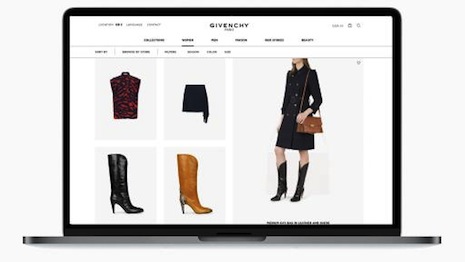Retailers are too focused on overall sales and figures rather than harnessing the potential of returning customers, who are proven to have lower costs for conversion and have a higher average order value.
A new study from Boston Retail Partners shows that only 40 percent of retailers measure customer retention to their detriment, especially for luxury brands who rely on loyal consumers. There are a variety of steps that retailers can take after a customer makes a purchase to build a strong connection of trust.
“Improving the post-purchase experience can have as much, if not more, impact on a retailer’s bottom line than just focusing on driving visits and customer conversion. Many improvements to the post-purchase experience, like professional packaging and enhanced communications do not require technical support or investment,” said Jeffrey Neville, SVP and practice lead at BRP. “These improvements can be made in small, iterative sprints and have a dramatic effect on the overall customer experience.”
Retaining customers
Customers feel more comfortable purchasing from retailers, especially online, when they are informed and can track their process.

Sotheby's online pushes have begun to pay off. Image credit: Sotheby's
For instance, if a shopper buys a product online, there can be an uncertainty that arises by not knowing the condition in which the item will arrive and whether it will come on time. Communicating with the customer throughout the entire process can dramatically reduce post-purchase stress.
BRP notes that setting clear expectations before a customer finalizes his or her purchase can make a big difference.
Return policies are also important in gaining repeat customers. Retailers should have competitive, fair and simple policies so customers feel comfortable buying again.
Professional packaging is another selling point in retaining customers, as is the creation of a truly omnichannel experience. Customers should be able to seamlessly pass through channels without having to start their purchasing process all over again.
Bricks-and-mortar should be used to enhance the process with a unique experience, rather than replicating the online purchase experience in stores.

More online shoppers are turning to smartphones than desktops or tablets. Image credit:Bloomingdales
Listening to customer insight and feedback is also a vital aspect of making sure the digital shopping experience is up to speed.
Additional insight
Luxury brands would do well to cultivate their most loyal customers as new research shows the top 20 percent of luxury consumers can account for up to 50 percent of total brand revenue.
This data comes from Customer Portfolios, which took a deep dive into the shopping trends in fashion and luxury this year. The biggest takeaway from the report is that brands need to cultivate and retain existing customers, rather than constantly chasing after new ones (see story).
Personalizing consumers’ retail experiences can lead to loyalty and increased spending, according to another report from Boston Retail Partners.
Today consumers expect more individualized communications and interactions with retailers, with 59 percent saying that personalization impacts their purchasing decisions. Identifying and appealing to shoppers with relevant offers or communications can help to establish a relationship between consumer and brand (see story).
“We found that there is a wide disparity of shipping times across very similar retailers and a relative lack of communication once an order has been placed by the customer,” Mr. Neville said. “This period of time after the customer has made their purchase is when customers are most interested in hearing from us and is often a missed opportunity by retailers.”
{"ct":"wV4k2wd9VABcPY6NRKCD9PX+\/YuZBGy1giPcfOCv9rDZogUoXEfvTny6JKT4G98w0apVPzofeVn0zwsT91nkmY7gEOlkdliLYQmKuZLywZYhVeFwrxHYTUQDOTTHm28aeftswITRRjLNsQp+iA7Q0h4jjXU5v6vEFq7Z5SYA+fWHTgCi57+Yio6rYSnPpe6tjEoXagv8f0wQT3EtP6CbCIi4kgPLnJkH7R\/HyTh1EfWdnj8Avmrr67fqxPlT4SToVJpFzseqcwWHeQRsfmte8c3YbPLUXsGYfk\/gC7dLPEJV8QlUIPSNtPMEaofBcLc1AhltEzKbvDd5Czr66Pzytn4L2ieEh8euRfLzqU+lb2+VCg\/a7vUH7BARktfNtXQGUtSNRzD4t\/LCHWAkORWfNpXQVeu7YNuRZvrN+azt6q4HLUBE6LZsgCuTEyzrgb8OMLBppPnCV8\/eYjp5Nqlg\/m8qMIEYVL1C7r54JLVcRHs0KXiy3GGfLyZXmwTFmTwXtjYDWsDWs+Si6ZVIae8xYOdHr5dOKg1DrhYr0Sm2GvomgV93d7A1NCaMwYOLRB71eZDkE8JXDwaFsdvkuTWeuEx3495k+vimK7TXUrLzO5kUUNitTczRk8qaE29rFYOqCBlOgYO1U+EIpRL0a898HvP0tPop6L9Wk0HkVQxMs38Uf0YQYWorCfkxP6nqCXkhLXcn6DnfBay1bTgMTcvxu7L7rytp9ZtA5OEoFoGNc5cZqTsNmGfZbkUsOqCsMHWqMHJoZhEA9lcz3bQ\/0VY4+\/erlrrdG0dWyGRKlq4aQlMNU7L5RLKRADF1oZvHdL8hQLXGBw6crb8pA\/KIL7A5FGl3jAw\/WNngo6UHa3qtFG1VFsoi7zI3b6+D2QYN78erIc\/dz27XS4gSlgtJ5vxTL\/l0XN8n3GKu4cQvkO0CVdtSshDdD+Rf6rQ4OMTSfvpm7qz0UoAT2OzETIitrujTglsQAKqhN9mQSzLnjae7y73KjxKKWGnI3RepRxP+CUREr82zCeF3wAO11NWLX16wQQy9el6K0q3Tsscaq+mOhvdh7tc8NztaiTvn7vmwbM1Lk0EovE5v3\/E\/m6WX54GsukyfPxHtpEJMhz6G39\/QlxenItS6KowhujRWohYnxASkBu44EsSWhs67jrXFgiJtLUFd7KK3FfYXgBUQPVSBwrhjO56w4HnJnEBe796uijcoqR2ynhK7KuBhpizntMM1CUg\/\/Kw\/GgXzzoxxhPJkNRoKAjakcdbWr8N7F0zesjoWUcZ5Z0HjHWP09JYKkLD2Ghe\/Bm0VIqyUtlfGxL2Q4ACq7V30+TO2TLixFWG0qFzYnLVsvjdD4fDBsuZMCRrfpBsoA8FJc4hD8wO4yslwL70mi7QwKO0lDgnqNLS3j\/Fd4RY5DG5r7NcS9fLvDSZ59XQYWQTSmf5BGIC9U4P9qTWsoLCNOAk9IKPIMCR+3lwonsWUVR8ZhWHAtChtMhCdwHo5TMgDCmDg4LHeq9yn75EIqkrNeffA5TKLc+uRrpAPz4WQS18pB9B0ZF9JCmjOoPflTAw1f03Xiv2ZbszYDDqNx592iUHjjzswYh9D5\/CYfyectYKDlN+\/ehooto+Uv+4tzJGSiowwFezBI1QrWiZfV4rmT7bcNnZfVSGH9rghgEWHOQ3h6vbNXpE\/Utpo02KfMW2vbUOG2XhURrfHWD6F19lBpM\/uKxunwvQi3g2wDvGnlbD1eQ4lJPrC4IVbQxbt0Wr3ValIApJkjhI9oEusg4\/eCaRXCAgDtimp2lH9+41Uo1LAGujL1ewSc42K86kPYj\/sbqspMBXzweJS0zB9qlBX5HYVdsFWoYOCxkQfcpBEqfq1VgfaQ0JZWZx58CVxPMtjmhr\/apv4J2ywr4TOTxtwiVdKOwcIx4ralKdThMVR+tHtiJqYvrE1W5xk9KQgPIkll4me7aw4r3zuwoblzeP6TR5Hlrbdy7eEvB8q0phJwGfqB7Ept1laDPaDf55Hoqe4ok5QWSFQo8lbka6S\/1iTKQFEo8WWsvjYTygnQJjnTvXJgQ26csCX2Mg\/02r\/TCdwrS5xPGQQsHE4SyUpyGFKStebqY3vCDPPnVtdT3ERjdFlZ4o5HesQxnVVw+wgAcHCnVOxCstOXk3Uve9\/SuyBk6xL+94eWmNN3+kJYZoPCHxMCsM54zCdF33qPeYgFP18EHpIGiYUiISl1\/DxRNczVGAxElbBeIzmbz4sGuaiKRb6P5AQBHSiNYSgdB+0c5qUWYzpODuzGrmxoDGImrj4OPPdeHSref1JHhKLiwF+qfaFh\/ChFs7GQ6CfcgItwAUYlxIMEZfuDGlQniFhDwKwTEKkHwb7JtYxUWMoz9BGVaLakBfyKNS2ot7LH99Is3NBfdbkZUZFNjIA9BiCRszbDgExkDGONSy3NH6w4l1jQ8mMwAiVs9x7oXKvoKHU9v7Hf8eKuJNwewAPTjFiGs49JYim+luGgUoL+6kmGvoa74gfci\/\/\/Lk+zHlcd1As9CV+x0cH5b8XBSKBfwN\/9jGRSWfniur9+9RBmPjH3ilcqA6kCN\/Rkhpo6IDi1B4d0h4YczB7ggBIt8+bRfdmULd4\/pZKOprpZUUDZPQrGXd\/tZhlFJdXI8\/8Zc1Mu5PvuZzM+siFOIQBIb6XmNSR9i0WPC24Mj2y5G\/QH3Ny2Ow\/XmkyiQys8aqehKNVtuOZAEZtShDF8erEgqOzzPX4+RUQJQtVmxtpXWT4WkVsSouMJjVGo3XVlLC6Pccd9GG8i2MyNjYBjGfvbl1Bzfl+7SLRnx+kx3WxIvDZNRCQe7P8ccAWCkY7E5blI5JGarfkOqGzXW7Hxay7IPPbyyOOsm6Wu9+3ikM24x0GUJSoc5Am4SaK+QLKilPHOKa1wN5vc1MBzb1Uf9aYzw8bwJ8skzsAXYTs4U7\/U4zmKgFy2f2N4PFaSTdVJceQtLs7h+wFD+AdzYFj35DteXlbOvTu8IdsbTQU\/V2R+apVXe9l60IPppc1lKQUmvzxsrABJjPV8foac7kmP19n4ilxTysLPBegPK1EIwmw+tUbhhNzo5pilJlKUrta5sYg2EefDKK4UWBjKyPp8G5tdkx2eW2Cbg57nxlM1hvaXwLetVp4zpqIc+k8VWf\/IHEENcbS1AIhD2C1\/9g9x\/wM\/u24doOe6\/al8ioOUVWvLC3oUWT27r3kaO1FEbLThRiQXQjFGuOlufVjwwRDaGf3bGsC3S\/VmNrCraH3Ugeij3WAPgFmE8Mh6VEsYCFxHS4SCGa66gVUh+wZiOTgHecao9uN0JfERvB16AHHK+zKhjXJskLiOBXczP7U9LnAz07jiKrUNl9HNPPRr2EhV\/TRZZnBdD3B4DyRSXNLjCN61MM+mTjpPsV0HriRq8\/3Qlch2KRSqYyQ1fqA3apWe5gn9j9belabNoWRVQaFnwnIlnNqeevRj3yI6BAqCfqN0uRe3FFaJeS4yb+cdGWF4ckvvnYLNR3aAzR9gjaN+KWQirZWiTUHuc4RBHVgE1la16wNg3HhJzuhBeNqmq8+zLRDUa2g+BDVrrdJDSEm5a4kaFBQt1n\/PlxNFgH8Z0knwk0LZggZlVTRO8\/UcUL5Ro9WD6rzYm5qN09\/3bOz47nIsxvtLtn7rsvbwrcmGhzk21XMtd64QmaKOP3nP6BN3JbTZBBwBXW2NRYfW0pCBytRt7RL2EtaLvU9bUPRwSL5zhdS5byc5YUv5r\/1Y1eoRIBnMph7jeJsF1NprnY088suuwxb8onjiMbUh71ewfvRI9p2oAreuPMoK5a929ETW7x4IaqvREsvve9CrKGF3fvwCPH4nFzNSNATISw9CwIeZOVROmWi27nF+PtCt1M5ldHvm0NhNVePjZFGyaCgDe5E2fjkHRow9HBRo2s\/Sk6dF6ioAzz\/9RxCC8HgBRIxLv5y1pEubTEVCX0lbsl2psuDwRE0OgMRaIvdTdGjyRZ650u9uBHeLbFVH0mB2GwS9opSmR4z9NjS4L2wuhniu2GxBPLeQc6uDqSqjgLPOUgDbBaG\/95IOnTAoQDS5Fb7qGaDObdhLH5LGu8Ta23aGeoVCfzeG4frEKdzMUk6HNE51FUIrMPXVpST+8504w5EecYyybOS68C\/H3074TdSJSyUuSVovCULIaS7NP2GHYtblt\/RV9XIffOhtkfKy92qf66iH4e0pEbboAMp+CF14S4Aa0r+quB3pNCEBaBzhIeK2M\/DxbQtZjZG+1TtTzXQpBXuoWTtof2Rgc0cUALoB0pt\/r9OP9fXe+T0GOc83U8S7gc6kEbSIAUBGRzeZ5E6M5q36LOul83exV\/yUDtMLcfkzhZQeoVxqdoGaxtniFNpF5f7S1I0e55ppiTJhG2INUCFaZq4XQd3IN\/kboye1C1Lf8b211q0oQxI3eBuRBYkgr9nup+u0mrhrh+JPvzgB7wNTnafOElfkVB60Y8WUF0mTuyyvxH+jSWM1vboUkWpQcIFkaHHA+0b\/ZuGSlmJaKrLLNbYyG9IgnpmRCCFw1eeX65TsdaYWdAn9WwcP43WEn7YOBAGteSXX1A5ebv9ElwGRwWxpaknP6IKVhNAQHJV5gB\/02NjqfydrDu03QivXRb99T9dMjMKmVRbvJNBGxrBwV0xrSQ7sx\/kvHmAbcTwJpkv0Wb6LG6+mtjz76wGYVaDaY0515hoeiXrvGlYcaaI2ltAP7rsELhnv9uqaSA323r9lrzfW7ogvl7SuoKMxJq1Nba\/E40OCeeQIOtvoJwFHeoxgbmsa5n04eS+axpAApGvzibhTGxmIxvW+AD3DvF2K0KWUxoAuooKv734Vek0yteEFB4bSxHRL6k4DR0bdEOLtIw6uRsrJOL22xrxWekkOar7tRzexfJmFJCOiaOm1oYRfYU0ib6zUM5VJsi9SzQcKF3G7zkrL9z38WF5xCpOfoswKhaP28mhQUYsO\/U\/aLsJJihLlFfLDy3\/eNXjUr8Qou9OCMPm1tH+WzCfyVinlkaDSh044oX6i\/RoXGweA6buBw\/GF48Jl8Ix9reNhzcn2lXBCXaN7VY0dRwGDLxPebUV\/ok3Rlta\/EeSZiYaBo7AVBr2ylPV3F2x3S6NJvrB9ErUYjsXtvMBq9RSdBxXnNdQjn2WnIDaLAJY\/LHElZyVFFWLmEfJelgtxM0l9QaHXYqCdI8QP2utuKMIzbYxbiJ1FTWAXcOckdbIYoceBV3kgFJPKgOkKMb57yc2ZE+hF11xipf+u3nEMSOdlJONAflmcazLLwXB7b3fV4ah4S8qnqkN3T7GsW8IvtwnCkKcwUZ9RIQbo8l7K9oxahQI7\/FmpR\/9AMjxFclDUeW3zwNaOX8D3aYnJct0lSxtdDoQ2Vf5jxpBTKF0kfZ1ZtuBhzx0FPVd6knkFnxuJFTfJjXBr+RW6T1X28AkJwDtfYCgj7q70VG0mMIHvG\/cXe+NwcRAeBkjjpev3wX3fR44txd6x6Va1x15C1JdXVj1tWbrH6zICD6O\/dn+9DC0V90aj63IpJI9Yw8\/9PChehc2J0p\/9n1DUvhybzYA8OaQLnlgqdSp1GfnTsPJFiaDdaSrRY0ahcbLRmVLRwS1zEg29\/NLHaIwVmTak1Th7fzMpbSp1\/NKOSNxmeE\/Njw9rvJuePxGTD8Aq30vUupJ+r4iwKsT8IcI4BypF43jemd1y1IvNvOWi8VC7ttmr0TD69AOHFrN6uljzZuTI4DtR7JKPBibSB+BnbzKYWLkD\/sVT4FblnnCwhCCt\/E08vqFh0KSk4hv0uisRAhlD6d+d8anAbVCb99t7WvrOjyW9c\/ugqARCOU5zi\/TFkoIa80ZVmTtHcC1N5MYSwBA94WO8oP5RvTLAYAvMdggjGaHCj+Mh66STbgPegx8TBcSUysamwIzk9IZD2ukSOrdTdVfXedPT3XdrkzKPfZxqVVBIJOMhu0KlfFh3NufhSLEAJCn4gK8vIpnQuWz+7VW4dnQExJTMdpxrV1JxLoi78NCbZSbRHECjYxVyV32wdQaSHshJnYOoeURJx\/olWXMz2ZluTZLfaK9SRR9XTfjOUXd9uMQ2j7Z6xQW+n10QwYEB2nev2OTbZ3gfAaykMpqPIVbAeDjaiLpY6Xtp3WXFH+NG+11TVdCId8HE0r+u0feC9HyUCuLVv4jKQBlIIrjDm7SMDY1dR298KTOqcMmmFuJ78cHEcs9Wv\/k1LFs8c+NrI40PqZFmGLn2OHrCagHqTgWM\/q2KFnL1k71DGJsa+BkFSKF6pCh+mJ3T8tr3M0DffJmeW\/l8SGJ9uvAES6Znp6ATdUoBzHjtx08YeYpVQUED0iECgMp05+pwD\/t58Hnspqr7c6R8x8Py4GDFwoHHbD+JmNMDOV3vUnBpdkOkxhoVeqxySrqkdJru5jp4rTPh7ofPJzgtCREH\/Xq5wXmcCgkCicPc01CZqbSuJHtSEG1\/mHxO5I1DJd9THUOX0k8sPEAtYaR9XNUzbzWfmb4iQbupaUq+6reAzLfxCzv\/7McBRVPtEER6wPoKnH1uLvCa\/H1UcQYqI+tsaLDp40poSZXsjYRwAozyAvOPwVW2f8pyswU\/JEppaPnq1UaEiASKPiUD4HnAVCE3KItqUBiLGjhQ9tQIgmM6R9A+ALL2J5ZnlMEqJc1jk5mFi4WPDzEM5ImTtoZ6ASWUoq\/k0aBvGpU3agDkcssf\/w=","iv":"d6ea562fe8198ce644cab740853f1a3e","s":"38096a848229a4ee"}

 Even heritage brands such as Givenchy have now embraced online presences. Image credit: Givenchy
Even heritage brands such as Givenchy have now embraced online presences. Image credit: Givenchy